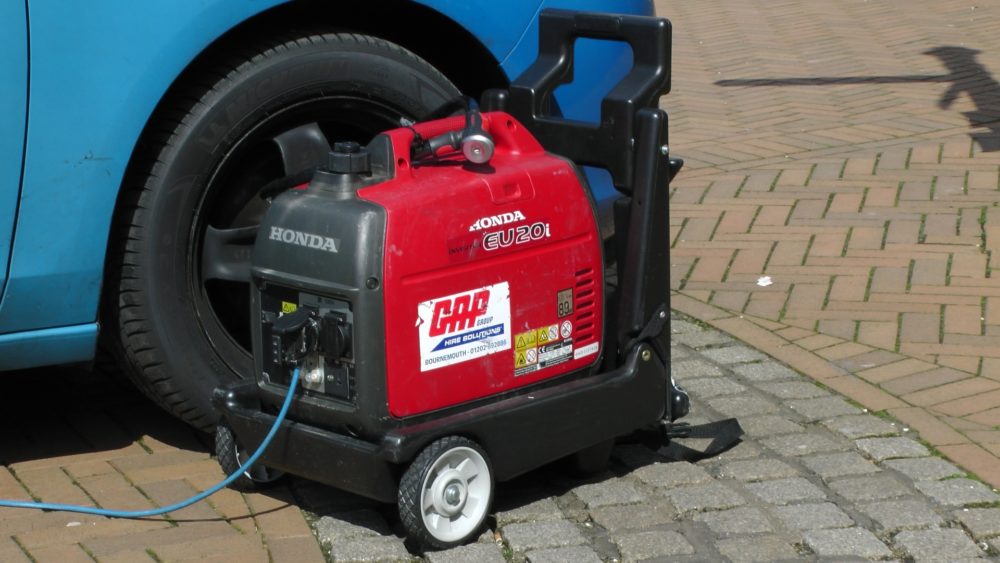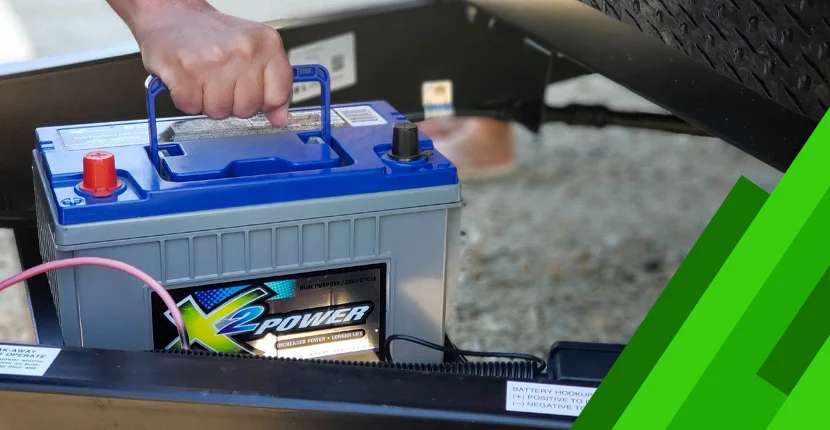Everything you rely on in your RV runs off a battery – it is the center of your RV’s electrical system. It, therefore, needs to be well maintained. But how do you know when it needs to be charged, and how do you charge it? Let’s find out!

How do you charge a dead RV battery?
There are four main ways you can charge the RV battery system, including:
- Your battery can be charged by the alternator whilst you are driving.
- Your RV’s deep cycle battery can be charged when you run your generator.
- You can install solar panels on the top of your car which can be used to charge your RV battery.
- Your convertor can charge your battery when it’s connected to your shore power.
You can also charge your battery at a camp power pedestal station. These power stations can usually provide between 30 to 50 amps of power.
Whenever you are connected to an electric outlet, your RV batteries will charge. You can check your battery is charging by looking at the battery monitor.
Contents
- 1 How do you charge a dead RV battery?
- 2 How often should you charge the RV battery?
- 3 What amp and voltage to charge an RV battery?
- 4 Types of RV battery chargers available:
- 5 Different methods for charging an RV battery:
- 6 How do I check the charge on my RV battery?
- 7 Does your RV battery charge while driving?
- 8 How long should an RV battery hold a charge?
- 9 How do you keep the battery charged on the RV?
- 10 So, which method should you choose when charging your RV battery?
How often should you charge the RV battery?
Charging, as a rule, should be done when 50% of the battery has been used.
Charging RV batteries once a month should be sufficient, however, it depends on how much you use them. It is best to consistently check your battery as you use your RV. You can even charge your battery when it is in storage by attaching it to a battery maintainer.
All RVs will have different batteries and there are many types, so first you must know what kind of battery you have. There are traditional wet cell batteries, lead-acid batteries, AGM batteries, gel-type, and lithium-ion batteries. Each battery type will run out at a different rate.
What amp and voltage to charge an RV battery?
Deep cycle batteries are normally 12 volts so they need to be connected to a power source greater than 12 volts. You normally need around 120 to 240 volts to charge it successfully.
Obviously, the greater the charge the quicker the battery will charge. Your home will normally have 15 amps outlets whereas cam power pedestal stations will have between 30 to 50 amps.
Types of RV battery chargers available:
There are several different ways to charge your battery system, including:
Solar panel charger
Solar generation is an environmentally friendly way to charge your battery and is great for those who like to travel off-grid. You could have a solar-generated panel fitted to the roof of your RV which is then connected to an amp or charge controller and then to the battery.
This will allow you to harness the solar energy from the sun whilst making sure you are not overcharging your battery. A panel of 100 to 150 watts will provide you with all the power you need in a day.
Multi battery charger
A smaller RV may have a single-stage charger, however, if you have a larger RV, you should consider a multi-stage charger. This works based on three charge stages which optimize battery use. The three stages are bulk, absorption, and float.
The bulk is the first stage where your battery can be charged to 80% capacity promptly from a low charge. The battery will be charging at 25% of the amp capacity. The charger will increase the voltage so the amps remain constant.
The absorption stage is when the voltage continues to flow until it reaches full capacity or the float mode comes on. The float maintains the voltage and keeps the battery at 100% charge.
AC/Converter charger
The converter charger offers a 12v function by interacting with the distribution panel in your RV. This converts 120v worth of shore power into 12v of DC power. The energy is stored in the battery whilst it is plugged in and can charge the RV battery when it has excess power.
DC/inverter charger
The inverter charger is similar to the converter but with the added ability of being able to produce 120v AC from the battery even when you may lack shore power.
Trickle chargers
Also known as a maintainer, this battery charger is a small single-stage unit that keeps the battery charged at 100%.
Different methods for charging an RV battery:
How to charge an RV battery with a portable generator?
- Firstly you need to refer to your user manual and make sure you know what kind of battery you have, for example, such as a standard battery or a deep cycle RV battery. You also need to identify what size it is.
- Next, remove any corrosion from the top of your battery and check the fluid levels in the cells, particularly if you have a deep cycle battery. You can use distilled water to fill the cells if they are not full.
- Wear gloves and eye protection because battery acid can be corrosive. Once you have started your generator, leave it to run whilst the voltage stabilizes.
- Attach the red clip to the positive battery terminal and the black one to the negative terminal using your battery cables. Next, plug your charger into the generator.
- When it reaches full charge you can disconnect it. Make sure to remove the black clip before the red clip.
How to charge an RV battery with a solar panel?
This is the most environmentally friendly and simple way to charge your battery.
- Simply place the panel over the top of your battery bank and attach the hooks to begin the charge.
- Leave it facing the sun all day and your battery will charge from the power harnessed.
- When the sun goes down, you can unhook your battery and use it.
How to charge an RV battery from a tow vehicle?
- Firstly you need to prepare the connection. The DC to DC charger should run from RV’s engine bay to your house battery.
- Inspect the line. Make sure you check for any scratches or issues with the protective coating. If you find faults you can use insulated rubber to fix them.
- Connect the wires. Make sure they are connected to the correct positive and negative terminals.
- Start your engine and run. As it is running it will be charging your RV battery bank.
- Once it is fully charged you can disconnect. Again, make sure you disconnect the black clip first and then the red.
How to charge RV batteries with shore power?
There are several methods of how to charge RV battery banks with shore power.
First method:
- Find an electrical outlet at a campground.
- Plug your RV power cable into the electrical outlet.
- Let the convertor change the AC power into DC so that your battery can charge.
Second method:
Alternatively, you could plug in a battery charger to the electrical outlet, and use it to charge your RV battery in turn. Make sure you’ve got a battery charger that matches your battery type. For example, you need a lead-acid battery charger for a lead-acid battery, etc. If you use the wrong battery charger, you could cause irreversible damage to your battery.
How to charge an RV battery when boondocking?
Boondocking is camping without the electrical hookups. It is sometimes called ‘dry camping’. Given that you won’t have electrical outlets handy, as you won’t be using campsites, you’ll need to be sure to have plenty of alternative energy sources ready.
The best option for boondocking would be to fit your vehicle with a solar power system and have plenty of backup solar panels ready. You should also consider investing in a small generator.
How do I check the charge on my RV battery?
There are three ways to check the charge on your battery, which are:
- By measuring the voltage with a digital voltmeter.
- By using the monitor panel on your RV.
- By testing specific gravity with a hydrometer.
Using a voltmeter is simple and good if you have sealed batteries. You can connect your battery to the voltmeter using the red and black terminals, which will give you a reading indicating if your battery needs charging.
Using the monitor panel, on the other hand, isn’t the most accurate way to test your battery. To increase its accuracy, make sure you are not plugged into the shore and turn on a few indoor lights. This will place a small amount of load on the battery and give you a rough indication of the battery’s charge.
The hydrometer will pick up a sample of the electrolytes in your battery. Before taking a reading, fill and drain the hydrometer a few times. It’s also important to put on protective gloves and eyewear as the electrolyte solution contains acid.
Does your RV battery charge while driving?
In most RV models the alternator will automatically charge the RV house batteries whilst the engine is running. This means you can charge your batteries while on the move.

How long should an RV battery hold a charge?
On average, an RV battery should hold a charge for 3 days.
How long a battery lasts depends on how you use it, how they are stored, the power demands, and the kind of recharging you do. Charging should take around 72 hours to fully charge.
If you take good care of your batteries and make sure they are well maintained, a charge should last at least between 2-3 days.
How do you keep the battery charged on the RV?
You can keep your battery charged using a generator or using solar-generated power. These methods will keep your RV battery fully charged long-term.
So, which method should you choose when charging your RV battery?
The method you decide to choose to charge your RV batteries depends on what you use your RV for, how much electricity you use on average, and the age and condition of the battery itself.
If you plan on going off-grid, definitely choose solar power generation or invest in a good quality generator, as you won’t have regular access to power sources when in the boondocks. Alternatively, if you’re planning on parking your RV at campsites regularly, you will be able to take advantage of shorepower, so wont be as relient on solar power and generators.
It also depends on what type of battery you have, as each battery type lasts for a different length of time. Consider all of these factors to decide how best to charge your RV battery.




